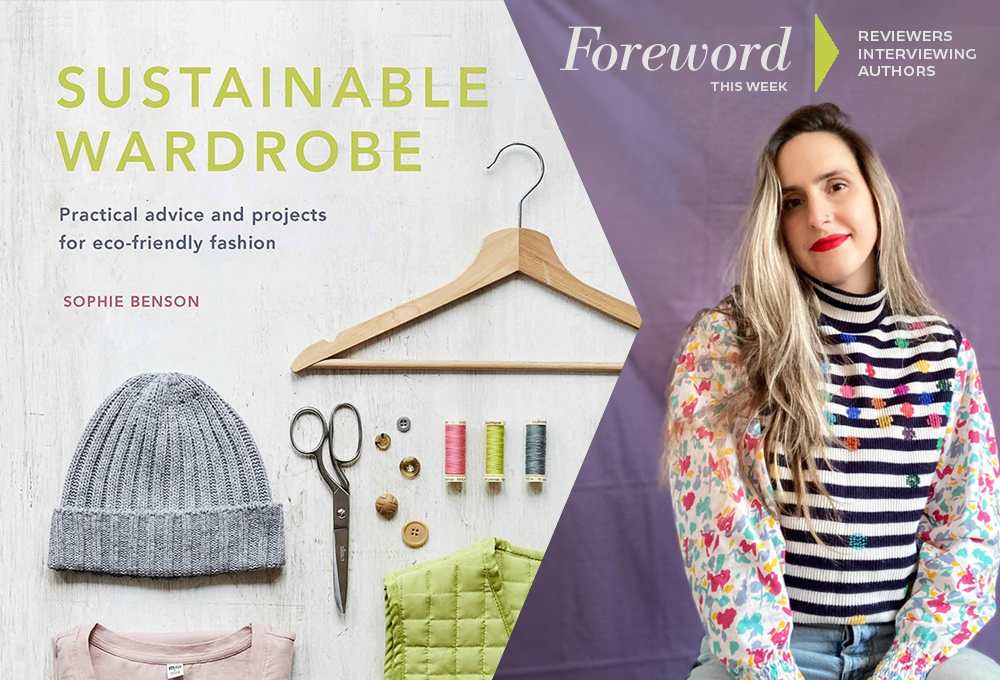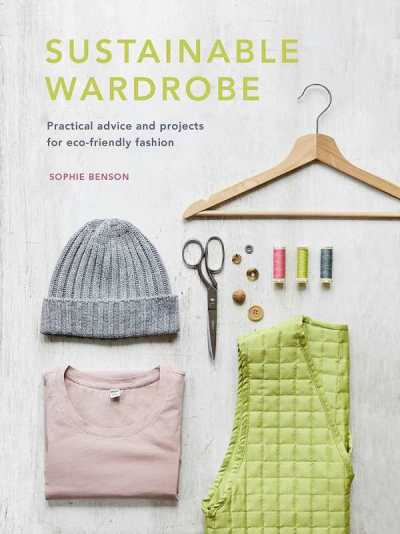It looks like you've stumbled upon a page meant to be read by our code instead of viewed directly. You're probably looking for this page.
Reviewer Allison Janicki Interviews Sophie Benson, Author of Sustainable Wardrobe

Among the myriad ways we can do the earth a favor, adopting a more enlightened approach to what we put on our bodies can be both fulfilling and fun. And if the movement catches on, remarkable progress can be made in lessening waste, moving the fashion industry away from fossil-fuel based fabrics and microplastics and improving the lives of garment workers.

Sophie Benson is with us today to talk about how you can make your wardrobe sustainable without sacrificing style. A former fashion consultant, she’s the new author of Sustainable Wardrobe, which makes her the perfect guide to changing our clothing habits for the betterment of our planet.
If not now, when?
Allison Janicki gave SW a glowing review in Foreword’s September/October issue, and with the help of the conscientious people at White Lion Publishing, we got the author and the reviewer together for a chat.
There are numerous tips throughout Sustainable Wardrobe for ways to upcycle and repurpose old clothing. Do you have a favorite upcycling project that you have done for your own wardrobe?
I must say it’s very hard to pick as everything I make has special qualities. However, if I really had to, it would be my Frankenjeans. I took apart two pairs of jeans that didn’t fit well and spliced them together into one perfectly fitting pair. I absolutely love them and I get so many compliments every time I wear them. In fact, I love them so much they feature on the back cover of Sustainable Wardrobe.
It seems like there has been a resurgence of slow fashion as more people are taking up crocheting and knitting. Do you think this is a step forward towards sustainability? Or are there still elements of consumerism with the amount of—oftentimes synthetic—yarn that is being purchased new?
The fact that people are willing to craft something slowly, stitch by stitch, is a huge positive step. Not only does it teach people the inherent value and skill in clothes making, it fosters a closer connection between the garment and its maker. You’re far less likely to throw a cardigan in the bin if you spent ten or twenty hours making it. However, old habits die hard. People have huge stashes of fossil fuel-based plastic yarn, so much that it may never even get used and that’s certainly an echo of the overconsumption that fuels the fashion industry. I’d encourage people to buy yarns secondhand wherever they can, buy according to what they need, and pay as close attention to where their yarns come from as where their clothes do.
In the world we live in now, where items can be purchased online and arrive at your doorstep in less than a day, it’s easy for consumers to fall into the trap of this cheap and instant gratification. Do you think there will always be a future for this type of shopping? Or, is it possible for behemoth brands like Shein to foster more sustainable practices?
My hope is that policymakers step up and we can regulate our way out of this system because it’s clear that brands aren’t going to slow down of their own volition. As you say, cheap and instant gratification can be a trap and there are both psychological and physiological drivers that keep us tapping into that fast consumption cycle. Lots of people are beginning to change their behaviour—buying less, adopting slow fashion values, upcycling, shopping secondhand—but it’s unrealistic to expect individuals to drive the wholesale change of this global industry. I believe some brands may weather the regulatory storm and may shift their business models somewhat but I imagine (and hope!) the likes of Shein, who are built on that desire for instant gratification, would fall by the wayside if the measures are strong enough.
You worked as a stylist in the fast fashion industry before leaving and focusing your career on fashion sustainability as a journalist. Can you tell us more about that experience, and what made you finally make the decision to leave? Additionally, what pushed you to combine your knowledge and experience in the field to write Sustainable Wardrobe?
I thought being a stylist was my dream job but I quite quickly realised it was making me miserable. My dream was to be an editorial stylist for fashion magazines but without the family money to support a move to London, or unpaid internships, I just couldn’t get my foot in the door, so I ended up working in fast fashion e-commerce studios to make ends meet. I hated it. There was no creativity, the owners of these businesses were never nice people, there was a constant churn of trends, and the quality of the clothing was appalling. I felt like I was selling shoppers a lie.
Away from these studios, I’d started to undertake more research into the social and environmental impacts of the industry. I remember the turning point very clearly: I was in a shop, going through the sale rail and I imagined all the hands that had touched that garment, all the ways in which those people might have suffered just so I could have nice clothes. I put what I was looking at back on the rail, walked out of the shop and quit fast fashion cold turkey. In my career, my financial position meant the transition had to come at a slower pace. I revamped my website and started to focus on writing about sustainability issues, pitching editors as often as possible. For a long time, I didn’t really get any responses at all but I kept writing on my own website, posting on social media, and trying to grow my voice. Eventually a few kind editors started to take a chance on me and it grew from there and I was able to move from styling to writing. I felt like I wished I’d known about the damage the fashion system was doing from the get-go and I wanted to be able to share that knowledge with as many people as possible.
In terms of putting this knowledge into Sustainable Wardrobe, I’d previously started working on a book but I had the feeling that I would be telling everyone what was wrong with the industry without offering any solutions, and that’s a recipe for disaster. A few years later, I was actually contacted by the publishing company and asked if I wanted to write on the topic of sustainable fashion, so I combined my existing research and knowledge with new research, interviews, and, importantly, practical advice and projects which help people become active in the system change.
There are numerous interviews with fashion and sustainability experts throughout the book, including a factory worker, a fashion psychologist, and other champions in sustainability. How did you choose who to interview, and was there anything that you found surprising or particularly revealing about the industry from these interviews?
The most important thing to me initially was to make sure there was a garment worker voice in the book. Journalists spend a lot of time talking about garment workers but we must make sure we speak to them as well, amplifying their voices rather than speaking for them. I’m incredibly grateful to the Garment Worker Center in LA for facilitating my interview with Paola Vega.
For the other interviews I really wanted to get a range of different insights. Liz Ricketts from The Or Foundation has such incredible knowledge of the impacts of overconsumption and waste colonialism, fashion psychologist Dr. Dion Terrelonge is able to get to the heart of what motivates us to overconsume, Layla Sargent (founder of repair platform The Seam) is at the forefront of implementing more circular fashion models, and Alexander Nolte of Guppyfriend has been instrumental in sparking the conversation about microplastics. The more voices I can add to the conversation, the broader view readers get of the issues and the solutions.
What does the perfect “sustainable wardrobe” look like to you? Do you think it is something that everyone can achieve?
Honestly, I don’t think there’s one definition of a sustainable wardrobe because it depends so greatly on people’s values, their access to resources, their lifestyles, and even their fashion sense. For someone incredibly social, a sustainable wardrobe might be renting a glamorous outfit every week, for someone else it might be only wearing items that have been made from secondhand fabrics. One person might have a wardrobe chock full of old fast fashion that they’ve kept for a decade after giving up shopping that way, another might buy three items per year from small independent labels using responsible manufacturing techniques. I think those differences are what makes sustainable fashion so wonderful. You can tailor it to your needs and desires, and therefore it’s achievable for everyone within their own specific parameters.
As a journalist, I’m sure you are always busy writing. Do you have any exciting upcoming projects?
Currently, I’m juggling a ridiculous number of deadlines and while all the articles and reports I’m working on are really interesting, it does make it difficult to focus on anything larger for the time being. However, I do have the early crumbs of my next book scattered across various notes and documents, so I’m looking forward to carving out some time to get to work on that!
Allison Janicki